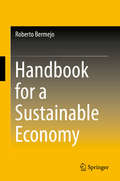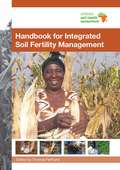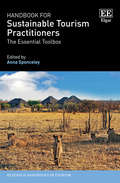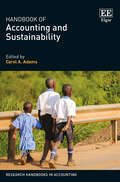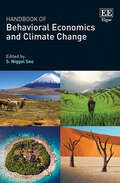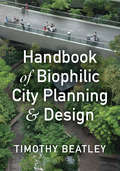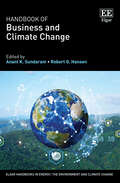- Table View
- List View
Handbook for a Sustainable Economy
by Roberto BermejoSince the 1992 World Scientists’ Warning to Humanity, the looming prospect of Earth’s changing climate has inspired a broad movement dedicated to a sustainable future. In this Handbook, the author explains the elements of a sustainable economy, the development of which must be undertaken if we are to retain our civilization.The first section offers a critical analysis of orthodox economical thinking, and the tools used by the conventional economy to solve the “environmental problem.” The author examines the theory and tools of Environmental Economics addressing the commodification of nature, and offers analysis of the theoretical and practical contradictions which arise from attempts to combine environmental protection and free trade.Part II discusses the principles and tools needed to build a sustainable economy, including the concept of biomimicry as a guiding principle of sustainability, a brief description of the adaptive cycle of ecosystems and explains the concept of transformability and the factors that determine it. Discussion includes a broad evaluation of the capacity for transformation of National Sustainable Development Strategies and an analysis of the essential requirements of ecology-based tax reform. Also included is a critical vision of the dominant paradigm of science and technology.The third section explores sustainable production and consumption, discussing energy, transport, the circular economy of materials and sustainable consumption. Included are a detailed analysis of factors that determine the limits of fossil fuels, a description of the peak oil structural effect and its sectoral impacts, an overview of a sustainable electric system and a review of biofuels, electricity and hydrogen. The author concludes that only hydrogen associated to fuel offers a sustainable alternative to oil. Discussion includes a view of the structural causes of the current high-level consumption model through the lens of motivation, provision and access systems and a detailed description of policies that must be adopted as part of a sustainable consumption strategy.The final chapter undertakes the task of analyzing the capability of our societies to transform themselves to reach sustainability. The author broadly evaluates each factor, as a prior step to carrying out an overall evaluation and demonstrates that in order to accomplish a comprehensive analysis, a multidisciplinary group is necessary.
Handbook for Integrated Soil Fertility Management
This handbook presents Integrated Soil Fertility Management, commonly known as ISFM, as a key contributor to improving Africa's soil and crop productivity, especially for the key staples in the continent that include maize, legumes, rice, cassava, bananas, sorghum, millet and coffee. It is meant for training of extension workers on soil fertility management techniques in sub-Saharan Africa and for workers involved in rural development that would like to learn more about the principles of ISFM. The handbook is also a useful primer on ISFM for educational organizations such as universities and technical colleges, and organizations involved in the development of policy on agriculture and rural development that need reference materials on ISFM techniques. Produced by the Africa Soil Health Consortium (ASHC), this handbook is part of a series of materials and publications on ISFM produced for stakeholders including extension personnel, smallholder farmers, agro-dealers, policy makers and training institutions. Other materials include cropping and plant nutrition guides, policy briefs, training manuals and practical information for extension workers and farmers. See the ASHC website for further details. The ASHC works with initiatives in sub-Saharan Africa to encourage the uptake of ISFM practices. ASHC is coordinated by CABI in partnership with international and national science and agriculture organizations with support from the Bill & Melinda Gates Foundation.
Handbook for Sustainable Tourism Practitioners: The Essential Toolbox (Research Handbooks in Tourism series)
This insightful Handbook brings together the practical guidance of over 50 international practitioners in sustainable tourism. Applying strong research design principles it provides a workable and rational toolkit for investigating practical challenges while accounting for modest timeframes and resources. Expert contributors illustrate how to undertake environmental, socio-cultural and economic assessments that establish the feasibility of new tourism ventures and ascertain their impact over time. Chapters cover fundamentals including how to conduct feasibility studies and business plans, and address key topics such as visitor management and overcrowding. Offering how-to tools and step-by-step guidance, this Handbook combines academic insight with extensive professional experience to outline the best practices for an array of tasks to inform sustainable tourism planning, development and operation. Incorporating concrete solutions employed in numerous contexts, this Handbook is crucial reading for practitioners of sustainable tourism and agencies commissioning sustainable tourism assignments who are in need of innovative methods and up-to-date guidance in the field. It will also benefit tourism scholars, particularly those investigating practical methodologies for creating sustainable tourism experiences.
Handbook for Teaching and Learning in Geography
by Helen Walkington Jennifer Hill Sarah DyerThis exemplary Handbook provides readers with a novel synthesis of international research, evidence-based practice and personal reflections to offer an overview of the current state of knowledge in the field of teaching geography in higher education. Chapters cover the three key transitions – into, through, and out of higher education – to present a thorough analysis of the topic. With key contributions from top scholars, the Handbook investigates student transitions, exploring how students require different pedagogical approaches as they progress through university or college. A wide range of learning contexts relevant to the breadth of spaces and places in which geography teaching takes place is used to provide examples of how teaching and learning in geography can be enhanced. It identifies key principles including working in partnership and acknowledging the whole student, calling for the adoption of courageous pedagogy. With a useful resources section included in each chapter, this Handbook is a vital reference source for those teaching geography in higher education settings. Written in an accessible style, it will also be of use to early career geographers and those who are new to teaching, including postgraduate students.
Handbook for the Assessment of Soil Erosion and Sedimentation Using Environmental Radionuclides
by F. ZapataThis publication deals with soil erosion and sedimentation. Soil erosion and associated sediment deposition are natural landscape-forming processes that can be greatly accelerated by human intervention through deforestation, overgrazing, and non-sustainable farming practices. Soil erosion and sedimentation may not only cause on-site degradation of the natural resource base, but also off-site problems— downstream sediment deposition in fields, floodplains and water bodies, water pollution, eutrophication and reservoir siltation, etc. —with serious environmental and economic impairment. There is an urgent need for accurate information to quantify the problem and to underpin the selection of effective soil-conservation technologies and sedimentation-remediation strategies, including assessment of environmental and economic impacts. Existing classical techniques to document soil erosion are capable of meeting some of these needs, but they all possess important limitations. The quest for alternative techniques for assessing soil erosion, to complement existing methods, directed attention to the use of environmental radionuclides, in particular fallout as tracers to quantify rates and establish patterns of soil redistribution within the landscape. The concept of a project on the use of environmental radionuclides to quantify soil redistribution was first formulated at an Advisory Group Meeting convened in Vienna, April 1993, by the International Atomic Energy Agency (IAEA).
Handbook of Accounting and Sustainability (Research Handbooks in Accounting series)
This Handbook provides a comprehensive study of research, practice and policy at the nexus of accounting and sustainability, or sustainable development. Internationally renowned accounting academics in the field offer critical discussions of the topic to stimulate debate as the future policy infrastructure is formed.Chapters explain key drivers of developments at the nexus, critique those developments, summarise the findings of research on key themes in the field, and suggest areas for further research, offering evidence-based practice and policy solutions. The Handbook sets the scene by exploring accounting, power, social justice and unsustainability, before moving on to appraise the role of enterprise value-based integrated reporting in (un)sustainable development. It further analyses contemporary issues in the field, including climate change-related disclosures, accounting for greenhouse gases and emissions trading schemes.The thorough coverage of key issues in accounting and sustainability, and the analysis of research literature in the Handbook will make this a critical read for accounting and business researchers and students. It is an invigorating guide for policymakers and policy influencers, accounting professionals and business leaders looking to move forward in a more sustainable way.
Handbook of Advanced Magnetic Materials: Vol 1. Nanostructural Effects. Vol 2. Characterization and Simulation. Vol 3. Fabrication and Processing. Vol 4. Properties and Applications (Developments In Hydrobiology Ser.)
by D. J. Sellmyer Daisuke Shindo Yi LiuIn December 2002, the world's first commercial magnetic levitation super-train went into operation in Shanghai. The train is held just above the rails by magnetic levitation (maglev) and can travel at a speed of 400 km/hr, completing the 30km journey from the city to the airport in minutes. Now consumers are enjoying 50 GB hard drives compared to 0.5 GB hard drives ten years ago. Achievements in magnetic materials research have made dreams of a few decades ago reality. The objective of the four volume reference, Handbook of Advanced Magnetic Materials, is to provide a comprehensive review of recent progress in magnetic materials research. Each chapter will have an introduction to give a clear definition of basic and important concepts of the topic. The details of the topic are then elucidated theoretically and experimentally. New ideas for further advancement are then discussed. Sufficient references are also included for those who wish to read the original work. In the last decade, one of the most significant thrust areas of materials research has been nanostructured magnetic materials. There are several critical sizes that control the behavior of a magnetic material, and size effects become especially critical when dimensions approach a few nanometers, where quantum phenomena appear. The first volume of the book, Nanostructured Advanced Magnetic Materials, has therefore been devoted to the recent development of nanostructured magnetic materials, emphasizing size effects. Our understanding of magnetism has advanced with the establishment of the theory of atomic magnetic moments and itinerant magnetism. Simulation is a powerful tool for exploration and explanation of properties of various magnetic materials. Simulation also provides insight for further development of new materials. Naturally, before any simulation can be started, a model must be constructed. This requires that the material be well characterized. Therefore the second volume, Characterization and Simulation provides a comprehensive review of both experimental methods and simulation techniques for the characterization of magnetic materials. After an introduction, each section gives a detailed description of the method and the following sections provide examples and results of the method. Finally further development of the method will be discussed. The success of each type of magnetic material depends on its properties and cost which are directly related to its fabrication process. Processing of a material can be critical for development of artificial materials such as multilayer films, clusters, etc. Moreover, cost-effective processing usually determines whether a material can be commercialized. In recent years processing of materials has continuously evolved from improvement of traditional methods to more sophisticated and novel methods. The objective of the third volume, Processing of Advanced Magnetic Materials, is to provide a comprehensive review of recent developments in processing of advanced magnetic materials. Each chapter will have an introduction and a section to provide a detailed description of the processing method. The following sections give detailed descriptions of the processing, properties and applications of the relevant materials. Finally the potential and limitation of the processing method will be discussed. The properties of a magnetic material can be characterized by intrinsic properties such as anisotropy, saturation magnetization and extrinsic properties such as coercivity. The properties of a magnetic material can be affected by its chemical composition and processing route. With the continuous search for new materials and invention of new processing routes, magnetic properties of materials cover a wide spectrum of soft magnetic materials, hard magnetic materials, recording materials, sensor materials and others. The objective of the fourth volume, Properties and Applications of Advanced Ma
Handbook of African Development (Routledge International Handbooks Ser.)
by Tony Binns Kenneth Lynch Etienne NelThis handbook presents an extensive new overview of African development - past, present and future. It addresses key core themes and topics that are pertinent to the continent's development - including sections on history, health and food, politics, economics, rural and urban development, and development policy and practice. The volume draws on the expertise of over 60 of the world's leading scholars to provide a detailed and up-to-date analysis of the key opportunities and challenges that confront Africa, and how such issues are being addressed. Arranged by key themes, the handbook provides not only a historical understanding of the past, but also political perspectives on the future. The chapters provide critically informed analyses of their topics by drawing upon the latest conceptual viewpoints and applied experiences in Africa in the form of case studies to offer a comprehensive examination of the opportunities, challenges, key debates and future prospects. This handbook is an invaluable state-of-the-art overview and reference concerning many different aspects of Africa's development, which will be of interest to academics in all fields of African studies, and also academics and students working in cognate disciplines such as development studies, geography, history, politics and economics.
Handbook of African Development
by Tony Binns Kenneth Lynch Etienne NelThis handbook presents an extensive new overview of African development - past, present and future. It addresses key core themes and topics that are pertinent to the continent's development - including sections on history, health and food, politics, economics, rural and urban development, and development policy and practice. The volume draws on the expertise of over 60 of the world's leading scholars to provide a detailed and up-to-date analysis of the key opportunities and challenges that confront Africa, and how such issues are being addressed. Arranged by key themes, the handbook provides not only a historical understanding of the past, but also political perspectives on the future. The chapters provide critically informed analyses of their topics by drawing upon the latest conceptual viewpoints and applied experiences in Africa in the form of case studies to offer a comprehensive examination of the opportunities, challenges, key debates and future prospects. This handbook is an invaluable state-of-the-art overview and reference concerning many different aspects of Africa's development, which will be of interest to academics in all fields of African studies, and also academics and students working in cognate disciplines such as development studies, geography, history, politics and economics.
Handbook of Agri-Food Law in China, Germany, European Union: Food Security, Food Safety, Sustainable Use of Resources in Agriculture
by Ines HärtelThis book offers a new and differentiated overview of Agri-Food Law against the background of national and global integration of markets, and compares for the first time important aspects of the agricultural, environmental and food law of China and Germany / the European Union. In addition to the basics, it discusses a wide range of issues, such as the respective legal regulatory structures for food security, food safety, geographical indications of origin, climate protection, fertilizers, plant protection products, genetic engineering, water protection, soil protection, land resources and organic farming. In addition, it addresses key environmental impacts and developments in order to create integrated value chains. The increasing fusion of upstream and downstream areas is becoming apparent from primary production, to the refinement and trade up level, and even to consumption. Agri-Food Law is now productively taking these important developments into account with regard to the aforementioned countries.
Handbook of Agricultural Geophysics
by Barry Allred Jeffrey J. Daniels Mohammad Reza EhsaniPrecision farming, site infrastructure assessment, hydrologic monitoring, and environmental investigations- these are just a few current and potential uses of near-surface geophysical methods in agriculture. Responding to the growing demand for this technology, the Handbook of Agricultural Geophysics supplies a clear, concise overview of nea
Handbook of Alien Species in Europe (Invading Nature - Springer Series in Invasion Ecology #3)
by Delivering Alien Invasive SpeciesBiological invasions by alien (non-native) species are widely recognized as a significant component of human-caused global environmental change and the second most important cause of biodiversity decline. Alien species threaten many European ecosystems and have serious environmental, economic and health impacts. The DAISIE (Delivering Alien Invasive Species Inventories for Europe) project has now brought together all available information on alien species in Europe (terrestrial, aquatic and marine) and from all taxa (fungi, plants, animals). Thus for the first time, an overview and assessment of biological invasions in the Pan-European region is finally possible. The Handbook of Alien Species in Europe summarises the major findings of this groundbreaking research and addresses the invasion trends, pathways, and both economic as well as ecological impact for eight major taxonomic groups. Approximately 11.000 alien species recorded in Europe are listed, and fact sheets for 100 of the most invasive alien species are included, each with a distribution map and colour illustration. The book is complemented by a regularly updated internet database providing free additional information. With its highly interdisciplinary approach, DAISIE and its Handbook will be the basis for future scientific investigations as well as management and control of alien invasive species in Europe.
Handbook of Alternative Fuel Technologies
by Sunggyu Lee James G. Speight Sudarshan K. LoyalkaWhile strides are being made in the research and development of environmentally acceptable and more sustainable alternative fuels-including efforts to reduce emissions of air pollutants associated with combustion processes from electric power generation and vehicular transportation-fossil fuel resources are limited and may soon be on the verge of d
Handbook of Applied Spatial Analysis: Software Tools, Methods and Applications
by Manfred M. Fischer Arthur GetisThe Handbook is written for academics, researchers, practitioners and advanced graduate students. It has been designed to be read by those new or starting out in the field of spatial analysis as well as by those who are already familiar with the field. The chapters have been written in such a way that readers who are new to the field will gain important overview and insight. At the same time, those readers who are already practitioners in the field will gain through the advanced and/or updated tools and new materials and state-of-the-art developments included. This volume provides an accounting of the diversity of current and emergent approaches, not available elsewhere despite the many excellent journals and te- books that exist. Most of the chapters are original, some few are reprints from the Journal of Geographical Systems, Geographical Analysis, The Review of Regional Studies and Letters of Spatial and Resource Sciences. We let our contributors - velop, from their particular perspective and insights, their own strategies for m- ping the part of terrain for which they were responsible. As the chapters were submitted, we became the first consumers of the project we had initiated. We gained from depth, breadth and distinctiveness of our contributors’ insights and, in particular, the presence of links between them.
Handbook of Archaeological Sciences
by A. Mark Pollard Ruth Ann Armitage Cheryl A. MakarewiczHANDBOOK OF ARCHAEOLOGICAL SCIENCES A modern and comprehensive introduction to methods and techniques in archaeology In the newly revised Second Edition of the Handbook of Archaeological Sciences, a team of more than 100 researchers delivers a comprehensive and accessible overview of modern methods used in the archaeological sciences. The book covers all relevant approaches to obtaining and analyzing archaeological data, including dating methods, quaternary paleoenvironments, human bioarchaeology, biomolecular archaeology and archaeogenetics, resource exploitation, archaeological prospection, and assessing the decay and conservation of specimens. Overview chapters introduce readers to the relevance of each area, followed by contributions from leading experts that provide detailed technical knowledge and application examples. Readers will also find: A thorough introduction to human bioarchaeology, including hominin evolution and paleopathology The use of biomolecular analysis to characterize past environments Novel approaches to the analysis of archaeological materials that shed new light on early human lifestyles and societies In-depth explorations of the statistical and computational methods relevant to archaeology Perfect for graduate and advanced undergraduate students of archaeology, the Handbook of Archaeological Sciences will also earn a prominent place in the libraries of researchers and professionals with an interest in the geological, biological, and genetic basis of archaeological studies.
Handbook of Archaeological Sciences
by A. Mark Pollard Ruth Ann Armitage Cheryl A. MakarewiczHANDBOOK OF ARCHAEOLOGICAL SCIENCES A modern and comprehensive introduction to methods and techniques in archaeology In the newly revised Second Edition of the Handbook of Archaeological Sciences, a team of more than 100 researchers delivers a comprehensive and accessible overview of modern methods used in the archaeological sciences. The book covers all relevant approaches to obtaining and analyzing archaeological data, including dating methods, quaternary paleoenvironments, human bioarchaeology, biomolecular archaeology and archaeogenetics, resource exploitation, archaeological prospection, and assessing the decay and conservation of specimens. Overview chapters introduce readers to the relevance of each area, followed by contributions from leading experts that provide detailed technical knowledge and application examples. Readers will also find: A thorough introduction to human bioarchaeology, including hominin evolution and paleopathology The use of biomolecular analysis to characterize past environments Novel approaches to the analysis of archaeological materials that shed new light on early human lifestyles and societies In-depth explorations of the statistical and computational methods relevant to archaeology Perfect for graduate and advanced undergraduate students of archaeology, the Handbook of Archaeological Sciences will also earn a prominent place in the libraries of researchers and professionals with an interest in the geological, biological, and genetic basis of archaeological studies.
Handbook of Astrobiology (Series in Astrobiology)
by Vera M. KolbChoice Recommended Title, August 2019 Read an exclusive interview with Professor Vera Kolb here. Astrobiology is the study of the origin, evolution, distribution, and future of life on Earth. This exciting and significant field of research also investigates the potential existence and search for extra-terrestrial life in the Solar System and beyond. This is the first handbook in this burgeoning and interdisciplinary field. Edited by Vera Kolb, a highly respected astrobiologist, this comprehensive resource captures the history and current state of the field. Rich in information and easy to use, it assumes basic knowledge and provides answers to questions from practitioners and specialists in the field, as well as providing key references for further study. Features: Fills an important gap in the market, providing a comprehensive overview of the field Edited by an authority in the subject, with chapters written by experts in the many diverse areas that comprise astrobiology Contains in-depth and broad coverage of an exciting field that will only grow in importance in the decades ahead
Handbook of Astrobiology (Series in Astrobiology)
by Vera M. KolbChoice Recommended Title, August 2019 Read an exclusive interview with Professor Vera Kolb here. Astrobiology is the study of the origin, evolution, distribution, and future of life on Earth. This exciting and significant field of research also investigates the potential existence and search for extra-terrestrial life in the Solar System and beyond. This is the first handbook in this burgeoning and interdisciplinary field. Edited by Vera Kolb, a highly respected astrobiologist, this comprehensive resource captures the history and current state of the field. Rich in information and easy to use, it assumes basic knowledge and provides answers to questions from practitioners and specialists in the field, as well as providing key references for further study. Features: Fills an important gap in the market, providing a comprehensive overview of the field Edited by an authority in the subject, with chapters written by experts in the many diverse areas that comprise astrobiology Contains in-depth and broad coverage of an exciting field that will only grow in importance in the decades ahead
Handbook of Australasian Biogeography (CRC Biogeography Series)
by Malte C. EbachThe Handbook of Australasian Biogeography is the most comprehensive overview of the biogeography of Australasian plants, fungi and animal taxa in a single volume. This volume is unique in its coverage of marine, freshwater, terrestrial, and subterranean taxa. It is an essential publication for anyone studying or researching Australasian biogeography. The book contains biogeographic reviews of all major plant, animal and fungal groups in Australasia by experts in the field, including a strong emphasis on invertebrates, algae, fungi and subterranean taxa. It discusses how Australasia is different from the rest of the world and what other areas share its history and biota.
Handbook of Australasian Biogeography (CRC Biogeography Series)
by Malte C. EbachThe Handbook of Australasian Biogeography is the most comprehensive overview of the biogeography of Australasian plants, fungi and animal taxa in a single volume. This volume is unique in its coverage of marine, freshwater, terrestrial, and subterranean taxa. It is an essential publication for anyone studying or researching Australasian biogeography. The book contains biogeographic reviews of all major plant, animal and fungal groups in Australasia by experts in the field, including a strong emphasis on invertebrates, algae, fungi and subterranean taxa. It discusses how Australasia is different from the rest of the world and what other areas share its history and biota.
Handbook of Behavioral Economics and Climate Change
Situating a comprehensive microbehavioral analysis of the economics of climate change within a discussion of the most pressing global climate change issues and policy negotiations, the Handbook of Behavioral Economics and Climate Change is a timely collection of new research on the behaviors of economic agents that are essential to an exposition of climate change economics and policymaking.Chapters identify both microbehavioral causes of and responses to climate change by numerous economic agents, in doing so elucidating the relationship between climate policies and behavioral changes. This includes examination of individuals’ behaviors to cope with and adapt to climate change; the policy decisions aimed at altering behaviurs at individual, business, and international levels to achieve climate policy goals; and the motivations behind behaviours driven by culture, history, or religion with regards to climate change. These behaviors are contextualised within a global analysis of pressing climate change issues in land-based and ocean-based systems, including Sub-Saharan agriculture, hurricanes and sea-level rises in North America, Latin American Pampas, the small island alliance, South Asian rice agriculture, and hydroelectricity in the Himalayas.With a global scope, this Handbook will prove invaluable to students and scholars of climate change, environmental studies, and behavioral economics. With practical examples and case studies, it will also prove useful for policymakers working in climate legislation.
Handbook of Big Geospatial Data
by Martin Werner Yao-Yi ChiangThis handbook covers a wide range of topics related to the collection, processing, analysis, and use of geospatial data in their various forms. This handbook provides an overview of how spatial computing technologies for big data can be organized and implemented to solve real-world problems. Diverse subdomains ranging from indoor mapping and navigation over trajectory computing to earth observation from space, are also present in this handbook. It combines fundamental contributions focusing on spatio-textual analysis, uncertain databases, and spatial statistics with application examples such as road network detection or colocation detection using GPUs. In summary, this handbook gives an essential introduction and overview of the rich field of spatial information science and big geospatial data. It introduces three different perspectives, which together define the field of big geospatial data: a societal, governmental, and governance perspective. It discusses questions of how the acquisition, distribution and exploitation of big geospatial data must be organized both on the scale of companies and countries. A second perspective is a theory-oriented set of contributions on arbitrary spatial data with contributions introducing into the exciting field of spatial statistics or into uncertain databases. A third perspective is taking a very practical perspective to big geospatial data, ranging from chapters that describe how big geospatial data infrastructures can be implemented and how specific applications can be implemented on top of big geospatial data. This would include for example, research in historic map data, road network extraction, damage estimation from remote sensing imagery, or the analysis of spatio-textual collections and social media. This multi-disciplinary approach makes the book unique.This handbook can be used as a reference for undergraduate students, graduate students and researchers focused on big geospatial data. Professionals can use this book, as well as practitioners facing big collections of geospatial data.
Handbook of Biophilic City Planning and Design
by Timothy BeatleyThis volume offers practical advice and inspiration for ensuring that nature in the city is more than infrastructure—that it also promotes well-being and creates an emotional connection to the earth among urban residents. Divided into six parts, the Handbook begins by introducing key ideas, literature, and theory about biophilic urbanism. Chapters highlight urban biophilic innovations in more than a dozen global cities. The final part concludes with lessons on how to advance an agenda for urban biophilia and an extensive list of resources.
Handbook of Business and Climate Change (Elgar Handbooks in Energy, the Environment and Climate Change)
Summarizing the current state of knowledge on the links between business and climate change, this timely Handbook analyzes how businesses contribute to and are affected by climate change, looking closely at their centrality in developing and deploying solutions to address this problem.Contributions from a global collection of scholars and practitioners explore a broad range of key industries’ impacts and responses to climate change, examining corporate strategy and leadership in the climate economy, functional perspectives and corporate practice, and climate finance. Chapters use diverse case studies to analyze climate-related business issues, including supply chain management, decarbonization, consumer decision-making, and climate-related financial investments. The Handbook delves deeper into how businesses perceive the issue of climate change, how they are affected by and engage with it, as well as the impact they have and what this impact costs. Forward-thinking, it concludes with reflections from the contributors on what the future holds for businesses and climate change.Covering matters relating to finance, economics, marketing, operations, strategy, leadership and communications, this interdisciplinary Handbook will prove invaluable to students and scholars in business management, sustainability and environmental studies, as well as to sustainability officers (and their staff) in corporations. Addressing, as it does, a wide range of climate-related issues from the corporate standpoint, it will also prove to be a useful resource for policymakers concerned with enabling solutions to climate change.
The Handbook of Carbon Accounting
by Arnaud BrohéCarbon Accounting is a vital tool in enabling organisations to measure and report on their greenhouse gas emissions. As the need to respond to the causes and impacts of climate change becomes increasingly urgent, emissions calculations and inventories are a vital first step towards mastering climatic risk. The Handbook of Carbon Accounting offers an accessible and comprehensive presentation of the discipline. The book examines the different methods or instruments implemented by countries and companies – such as carbon taxation, carbon markets and voluntary offsetting – while revealing how these stem not simply from the aim of reducing emissions for the lowest cost, but more as a compromise between divergent interests and individual world views. It also explores the historical context of the emergence of carbon accounting, assessing its evolution since the Rio Conference in 1992 and the signing of the Kyoto Protocol in 1997, to the latest Conference of Parties in 2015 in Paris.The book concludes with a very practical guide to calculate, reduce, offset and disclose your carbon footprint.Like other management tools, carbon accounting may not be an exact science, but its contribution has never been more important. The Handbook of Carbon Accounting is a vital educational resource that will help readers – including those with no prior knowledge of the field – to understand carbon flows and stocks and to take action. It forms part of a movement that heralds the start of a new economic era in which the search for prosperity can live in harmony with the environment.
